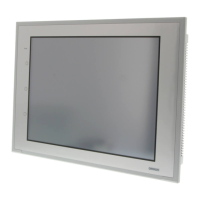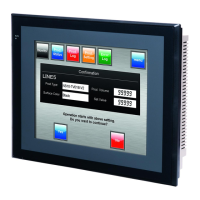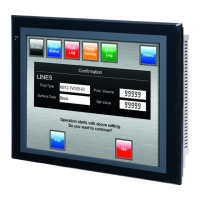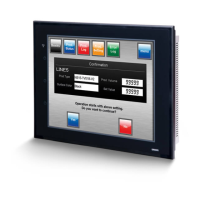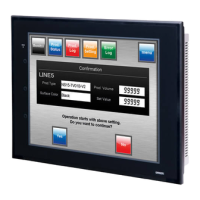6-6 Communications Settings
6-27
Reference
The unit number is the number used by the host to identify each PT when more than
one PT is connected to a single host.
The unit numbers that can be set depend on the type of host used, as follows:
• C200HE(-Z):
Unit numbers 0 to 3 (up to four PTs for each port of the host)
• C200HG(-Z), C200HX(-Z), CS1G/H, CS1G/H-H, CQM1H, CJ1G, and CJ1G/H-H:
Unit numbers 0 to 7 (up to eight PTs for each port of the host)
Refer to 4-2 1:N Connection to the Host for the host settings.
6-6-4 Setting Ethernet
To use Ethernet, select the Comm Tab from the System Menu and press the Enable Button.
The setting items for Ethernet will be displayed on the right side of the screen. Display and
set the network address, node address, IP address, subnet mask, and default gateway. Dis-
play the MAC address and IP address table display.
After setting, press the Write Button.
• Setting Ethernet Communications Conditions
Setting item Function Settings
Network Add. Sets the network address used for
Ethernet communications.
1 to 127
Node Add. Sets the local node address. 0 to 126
IP address Sets the local IP address. 0.0.0.0 to 255.255.255.255
(See note.)
Sub-net Sets the subnet mask of the local node. 0.0.0.0 to 255.255.255.255
Default gateway Sets the IP router. 0.0.0.0 to 255.255.255.255
MAC address Displays the MAC address (device-
specific information to identify each de-
vice connected to the network.)
Read-only.
IP address table display Displays the node number and IP ad-
dress of other nodes connected to
Ethernet.
Read-only.
Note: Do not set the following values for the IP address.
Host ID with all bits set to 0 or 1 (e.g., 192.168.21.0).
Net ID with all bits set to 0 or 1 (e.g., 255.255.21.16).
Subnet ID with all bits set to 1 (e.g., 192.168.255.16).
IP addresses that begin with 127 (e.g., 127.35.21.16).
